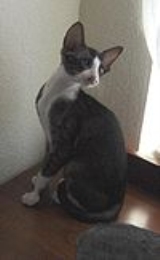
Oriental Bicolour
Encyclopedia
| Oriental Bicolour |
|---|
| Country of origin |
| United States United States The United States of America is a federal constitutional republic comprising fifty states and a federal district... |
| Breed standards (external links) |
| GCCF |
The Oriental Bicolour is any cat
Cat
The cat , also known as the domestic cat or housecat to distinguish it from other felids and felines, is a small, usually furry, domesticated, carnivorous mammal that is valued by humans for its companionship and for its ability to hunt vermin and household pests...
of Oriental type, either longhaired or shorthaired and in any pattern including colourpoint, which has white areas on its coat caused by the white spotting gene.
History
Although some experimental breeding took place during the 1970s and 1980s in the UK, including Pat Turner's Seychellois breeding program, the modern-day Oriental Bicolour owes its origins to matings initiated in the USA by Lindajean Grillo (Ciara Cattery). Starting in 1979, Grillo carried out a series of matings between Siamese and Bicolour American Shorthairs. She then selected the best Bicolour offspring to mate back to Siamese or Orientals in order to regain type. The variety was granted recognition by TICA in 1983 and the first champion was Ciara Quite-N-Oreo.During the 1980s European breeders, principally those in France and the Netherlands, initiated their own Oriental Bicolour breeding lines. A red and white female Moroccan street cat was used as an initial outcross, then later on a Black & White Cornish Rex. Further cats were imported from the USA. It was important for breeders to have different lines in order to be able to mate bicolour to bicolour and obtain a higher proportion of white on the coat, without excessive inbreeding.
FIFe
Fife
Fife is a council area and former county of Scotland. It is situated between the Firth of Tay and the Firth of Forth, with inland boundaries to Perth and Kinross and Clackmannanshire...
granted championship recognition in 2003 to the Bicolour Oriental Shorthairs and in 2005 to the colourpoint and white cats under the breed name Seychellois.
Although there was a small breeding program stemming from the last of Pat Turner's cats being kept by the late Barbara Lambert (Nomis cattery, breeding under FIFe guidelines,) this disappeared following her death in the early 2000s. The first modern-day Oriental Bicolours were imported to the UK starting in 2004 with the arrival of Black & White male Tassam Tom of Landican owned by Sarah Johnson and Pat Norman of the Landican Cattery. The variety gained official Preliminary recognition with the GCCF in 2006. In 2008 the breed progressed to Provisional Status, the fastest breed recognition within this organisation and a mark of the breed's popularity and success.

